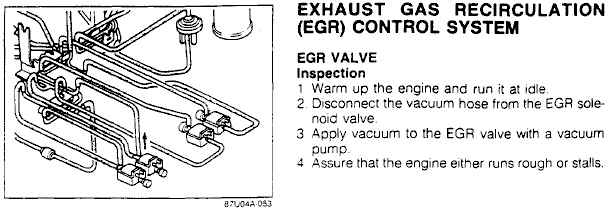EXHAUST GAS RECIRCULATION (EGR) SYSTEM
The exhaust gas recirculation system reduces emissions of nitrogen oxides (NOx) by injecting exhaust gases into the combustion chambers along with the air/fuel mixture to reduce combustion temperatures.
The EGR is located on top of the egine block, underneath the intake manifold. The EGR valve is vacuum operated. When vacuum is applied to its diaphragm, exhaust gases are allowed to enter the intake. It is controlled by a solenoid valve. When not energized, the solenoid valve does not conduct vacuum. When energized, it conducts vacuum.

This above is the FSM test to check for proper operation of the EGR valve. By applying vacuum to the EGR valve directly, exhaust gases should enter the intake when the engine is idling. This should cause the engine to run roughly if the EGR valve is functioning correctly. The EGR solenoid valve is located immediately to the right of the relief solenoid valve (see the secondary air injection control system under emissions).
The EGR solenoid valve connects to the main relay (12 volts when engine running) and pin 2N of the engine control unit (ECU). When pin 2N is grounded by the ECU, the solenoid is energized and, therefore, conducts vacuum. There is no available information about under what conditions the EGR solenoid gets energized.

This above shows the general EGR flow characteristics for a piston engine. However, this information may not be correct for a rotary engine.
Copyright © 2003 - The MAZDA RX-7 86-88 Technical Page - All Rights Reserved